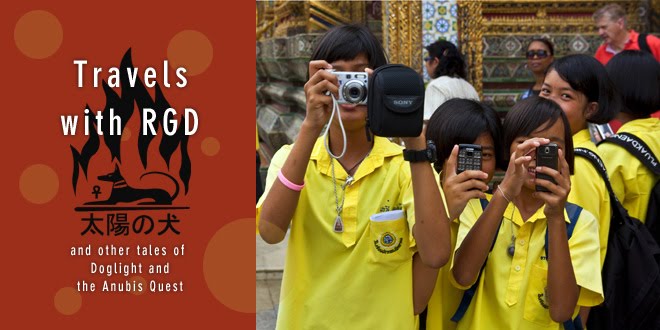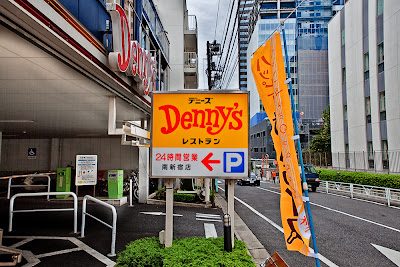(Tip: Click on photos to see a larger version or go to www.ronalddunlapphotography.com)
All rights reserved.
The clouds seemed to be retreating a little as I scanned the morning skies outside my window. I'd just finished watching the local TV weather forecast, and from what I could discern from the gestures of the "news readers," it looked like it would be relatively dry today; but then again, this is Tokyo and it is late in the fall.
Last night I'd spotted a Denny's on the circuitous route back to the hotel, and this morning I was making a beeline there for what I hoped would a glorious breakfast. The restaurant is located in a two-story standalone building, unusual in this part of town. The ground floor is actually the parking lot, while the restaurant hovers above. I took the stairs up to the brightly painted, ultramarine-blue eating establishment and pulled the door open. The layout was very similar to that of its American cousins, with a very relaxed atmosphere and lots of elbow room, unlike most of Tokyo's other fast-food-franchised dining rooms, which are usually cheek-to-jowl.
I ordered two eggs over-easy, bacon, toast, and a Diet Coke. The food was great, even if the portions weren't American-sized or quite U.S.-style, because in Japan over-easy, must really mean sunside-up. The best surprise was that the bill only came to ¥580, which was a lot cheaper than Mickey D's. You can rest assured that I'll be back tomorrow.
This morning my destination is Asakusa: Tokyo's major ("low town") pleasure/entertainment center during the first half of the twentieth century. Seekers of diversion would flock to the famous theater/cinema district from all over Japan. They were captivated by the flickering images at the Denkikan, Tokyo's first movie theatre, and entertained by the diverse offerings of the legitimate theaters in the area.
I took the train down to Shibuya, then changed to the Ginza subway line, where I pulled out my two-day Metro Pass and put it to work. Shibuya is the Ginza line's first stop, and Asakusa is the last. Because I was getting on at the first stop both coming and going, I would be able to get a seat going in both directions, which at my age is a benefit.
Travel Info: When you look at the train/subway map of Tokyo, it looks like someone dropped a plate of multi-colored spaghetti. The train- and subway-line configurations are so numerous and overlapping that it is daunting to even contemplate a journey. But I found if I just laid out the train stops in a straight line, one after the other, it was far easier to understand how to get from place to place.
Like much of Tokyo, most of Asakusa was incinerated during the fire bombings of WWII. In the 1950s and 60s, major portions of the area were rebuilt, and today many of the mid-century-styled buildings still stand, giving the area an "Old Downtown" ambiance that is a major draw for those who want to look back fondly.
Once I exited the subway car at Asakusa, I found the station to be a little run-down and very humid. After quizzing one of the station attendants, I learned that it was Exit 6 that I needed to use to get to the temple. The trip to the surface was a labyrinth of twists and turns past shabby places to eat that were yet to open for the day and still had last night's trash piled against the door. I surfaced into a covered mall-like walkway, very reminiscent of downtown Las Vegas but without the digital imaging.
The walkway from the station intersects the famous Nakamise Way that has been taking pilgrims to the Senso-ji temple since the 1500s. This path is lined with merchants selling their wares much as they have for the past five centuries. From corn-on-the-cob to delicate cookies, from samurai sword replicas to religious devices, the path is humming with commerce, giving a shadowy perception of what pilgrims might have encountered during the Edo (1600-1800) period.
Senso-ji is one of the most famous temples in Tokyo. Erected in 628 AD, the original building was flattened by the great earthquake of 1923 and then again during WWII, when its second incarnation was burned to a crisp. The present temple has survived the latest series of quakes and serves as a welcome island of calm and spiritual rejuvenation to the Japanese, who over the past year have suffered through a series of unsettling events.
Like many of the temples in Asia, you can avail yourself of a glimpse into the future here at Senso-ji by using the all-pervasive fortune sticks. Very similar to the experience I had in Hong Kong: you begin by grabbing one of the containers, then you shake out one of the sticks and record the stick's symbol. But instead of finding a soothsayer, as you would have done in Hong Kong, here at Senso-ji they have a series of drawers containing printed sheets that purport to prognosticate forthcoming events; that is, if you make the mandatory 100-yen donation.
After doing a photographic survey of the temple area, I moved on to the side streets, where the majority of artisans sell their goods. A whole host of traditional handmade items are available, from exquisite wooden combs to handmade writing utensils, in a concerted effort to keep traditional skills alive and well. I would have loved to buy something, but they were just a little too dear for my meager means.
According to the guidebooks, there are still 50 geishas working in Asakawa. I hadn't seen even a fleeting glimpse of them, but I found several shops that sold the accoutrements of their profession. One footwear shop had magnificent Zoros, and another carried kimono fabrics that were works of art. Really impressive stuff, their attention to detail is hard to comprehend, especially in today's attention-deficit world.
Kaminarimon Gate is at the southern end of Nakamise Way. It is a landmark in the area, and visitors are compelled to have their picture taken in front of it. The locals watch the activity with sense of bemused pride. One gentleman attracted my attention because he was taking pretend pictures of all he encountered. I found out that he spends most of his days here mentally framing and storing away the images in his memory. I showed him my camera and pantomimed taking his picture and he agreed. So I took a digital shot of him at the same time as he mentally recorded me.
Kaminarimon Gate is at the southern end of Nakamise Way. It is a landmark in the area, and visitors are compelled to have their picture taken in front of it. The locals watch the activity with sense of bemused pride. One gentleman attracted my attention because he was taking pretend pictures of all he encountered. I found out that he spends most of his days here mentally framing and storing away the images in his memory. I showed him my camera and pantomimed taking his picture and he agreed. So I took a digital shot of him at the same time as he mentally recorded me.
It started to sprinkle, and I found an umbrella shop, along with a several high-end luggage shop, selling exotic skin cases. They didn't have an all-black model, so I had to settle for a black with gray accents. I continued to photograph some of the shops, but the day was winding down and I headed back to the subway.
Even though it was raining, I got out at Shibuya and walked around a little, still trying to find the "pork ramen" house that I'd seen in a book, but after 20 minutes I was pretty soaked, so I took the train back to Yoyogi Station.
I stopped at the convenience store, got tons of junk for dinner, and headed back to my room. Once there I changed out of my wet clothes, gathered up the rest of my dirty duds, and took the elevator down to the garage level, where the coin-operated laundry room was located. I swatted mosquitoes and made notes of the day's activities for the next two hours while the machines worked on my clothes.



























































